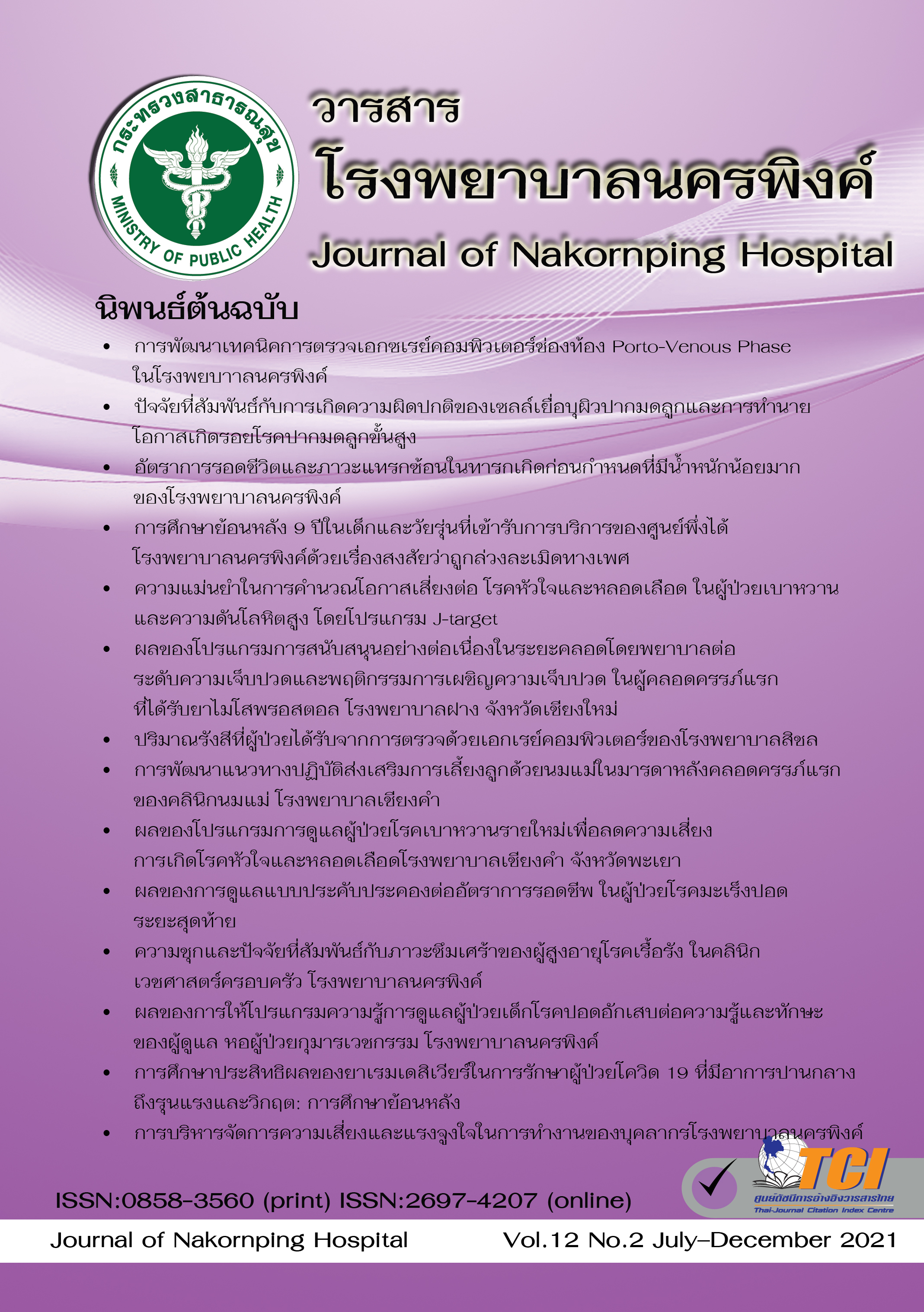Factors associated with abnormal histology in squamous intraepithelial lesions of cervix and prediction probability of high grade cervical lesions
Keywords:
High grade cervical lesions, HSIL, Low grade cervical lesions, LSILAbstract
Background: High grade abnormal lesions of cervix consisted of High-Grade Squamous Intraepithelial Lesions (HSIL) and Squamous cell carcinoma which are precancerous lesions and cervical cancer, respectively. The main cause is human papillomavirus (HPV) infection and the other risk factors such as age of first sexual intercourse, number of pregnancies and HIV status which promote the abnormalities of cervical cell line. This study aims to evaluate the factors associated with squamous intraepithelial lesions of cervix and to determine the chance to be high grade cervical lesions.
Method of study: Research design was based on cross-sectional study. The sample of this study was a group of women with abnormal cytology and abnormal pathologic results who were examined at colposcope clinic Nakornping Hospital. From the fiscal year 2016-2019, total data of 1,056 cases were collected from medical records. All women who met criteria were purpose in group of high grade cervical lesions (HSIL, CA) and low grade cervical lesions (LSIL, Cervicitis). All factors from the data were compared between two groups. The data were analyzed by independent T-test and Ranksum test, compared the differences between the groups with Fisher’s exact test. The probability of high grade cervical lesions was evaluated by multivariable logistic regression analysis.
Results: HIV positive women associated with high grade cervical lesion more than HIV negative group significantly (Adjusted OR 1.76, 95% CI 1.19- 2.60, p=0.005). This study found that the age of 30-60 years old was significantly more associated with high grade cervical lesions than the younger (Adjusted OR 1.71, 95% CI 1.14- 2.57, p = 0.009). Women who were over 60 years old associated with high grade cervical lesions more than women younger than 30 years old significantly (Adjusted OR 3.28, 95% CI 1.80-5.96, p = <0.001). There was no difference between high grade lesions and low grade lesions groups regarding age of first sexual intercourse, number of pregnancies, contraception methods, and menopausal status.
Conclusion: This study found that HIV-infected women and age over 30 years old have higher risk of developing advanced cervical lesions. Therefore, if cervical cancer screening results are abnormal, they should receive further investigation and treatment instantly.
References
Berek JS. Berek and Novak's Gynecology. 16th ed. New York: Wolters Kluwer; 2019.
Nation Cancer Institute, Thailand. HOSPITAL BASED CANCER REGISTRY ANNUAL REPORT 2017. Bangkok: Pornsup Printing; 2018.
Rodríguez-Trujillo A, Martí C, Angeles MA, Sierra A, Esteve R, Saco A, et al. Value of HPV 16/18 Genotyping and p16/Ki-67 Dual Staining to Predict Progression to HSIL/CIN2+ in Negative Cytologies From a Colposcopy Referral Population. Am J Clin Pathol. 2018;150(5):432-40. doi: 10.1093/ajcp/aqy071.
Münger K, Scheffner M, Huibregtse JM, Howley PM. Interactions of HPV E6 and E7 oncoproteins with tumour suppressor gene products. Cancer Surv. 1992;12:197-217.
ธีระ ทองสงค์, บรรณาธิการ. นรีเวชวิทยา (ฉบับสอบบอร์ด). พิมพ์ครั้งที่ 4. เชียงใหม่: ภาควิชาสูติศาสตร์และนรีเวชวิทยา คณะแพทยศาสตร์ มหาวิทยาลัยเชียงใหม่; 2559.
Tao L, Han L, Li X, Gao Q, Pan L, Wu L, et al. Prevalence and risk factors for cervical neoplasia: a cervical cancer screening program in Beijing. BMC Public Health. 2014;14:1185. doi: 10.1186/1471-2458-14-1185.
International Collaboration of Epidemiological Studies of Cervical Cancer. Comparison of risk factors for invasive squamous cell carcinoma and adenocarcinoma of the cervix: collaborative reanalysis of individual data on 8,097 women with squamous cell carcinoma and 1,374 women with adenocarcinoma from 12 epidemiological studies. Int J Cancer. 2007;120(4):885-91. doi: 10.1002/ijc.22357.
Chambuso RS, Shadrack S, Lidenge SJ, Mwakibete N, Medeiros RM. Influence of HIV/AIDS on Cervical Cancer: A Retrospective Study From Tanzania. J Glob Oncol. 2016;3(1):72-8. doi: 10.1200/JGO.2015.002964.
Ajah L, Chigbu C, Onah H, Iyoke C, Lawani O, Ezeonu P. Cytologic surveillance versus immediate colposcopy for women with a cervical smear diagnosis of low-grade squamous intraepithelial lesion in a poor setting in Nigeria. Onco Targets Ther. 2014;7:2169-73. doi: 10.2147/OTT.S70930.
Klumb EM, Araújo ML Jr, Jesus GR, Santos DB, Oliveira AV, Albuquerque EM, et al. Is higher prevalence of cervical intraepithelial neoplasia in women with lupus due to immunosuppression?. J Clin Rheumatol. 2010;16(4):153-7. doi: 10.1097/RHU.0b013e3181df5261.
International Collaboration of Epidemiological Studies of Cervical Cancer, Appleby P, Beral V, Berrington de González A, Colin D, Franceschi S, et al. Cervical cancer and hormonal contraceptives: collaborative reanalysis of individual data for 16,573 women with cervical cancer and 35,509 women without cervical cancer from 24 epidemiological studies. Lancet. 2007;370(9599):1609-21. doi: 10.1016/S0140-6736(07)61684-5.
จตุพล ศรีสมบูรณ์. การประยุกต์ใช้ HPV Testing และ Genotyping ในทางเวชปฏิบัติ [อินเทอร์เน็ต]. เชียงใหม่: คณะแพทยศาสตร์ มหาวิทยาลัยเชียงใหม่; 2553 [เข้าถึงเมื่อ 24 มีนาคม 2564]. เข้าถึงได้จาก: https://w1.med.cmu.ac.th/obgyn/index.php?option=com_content&view=article&id=378:hpv-test&catid=40&Itemid=482.
Denslow SA, Rositch AF, Firnhaber C, Ting J, Smith JS. Incidence and progression of cervical lesions in women with HIV: a systematic global review. Int J STD AIDS. 2014;25(3):163-77. doi: 10.1177/0956462413491735.
Chainual A. Comparison of the cervical pathologic results in Low-Grade Squamous Intraepithelial Lesion (LSIL) cervical smear between HIV positive and HIV negative women. J Nakornping Hosp. 2019;10(1):16-24.
Nakaporntham P. Clinical Significance of Atypical Squamous Cells, CannotExclude High Grade Squamous Intraepithelial Lesions (ASC-H) Cytological Abnormalities in Premenopausal and PostmenopausalWomen. Srinagarind Med J. 2016;31(5):290-6.
Kapeu AS, Luostarinen T, Jellum E, Dillner J, Hakama M, Koskela P, et al. Is smoking an independent risk factor for invasive cervical cancer? A nested case-control study within Nordic biobanks. Am J Epidemiol. 2009;169(4):480-8. doi: 10.1093/aje/kwn354.
Natphopsuk S, Settheetham-Ishida W, Sinawat S, Pientong C, Yuenyao P. Passive Smoking is an Independent Risk Factor for Cervical Cancer in Northeast Thai women. Srinagarind Med J. 2010;25(3):215-22.
Downloads
Published
How to Cite
Issue
Section
License
The articles that had been published in the journal is copyright of Journal of Nakornping hospital, Chiang Mai.
Contents and comments in the articles in Journal of Nakornping hospital are at owner’s responsibilities that editor team may not totally agree with.



